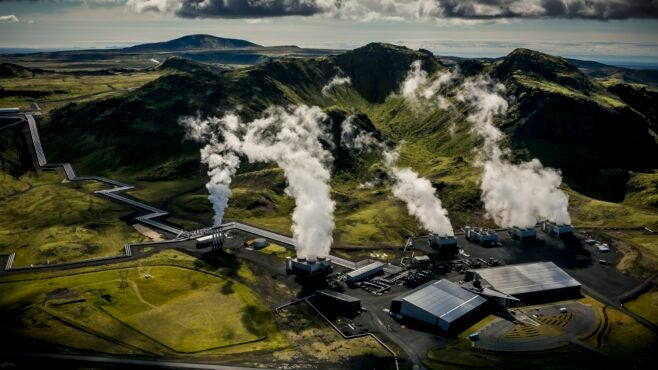When travelling over the mountains east of Reykjavík, it is impossible not to notice plumes of white steam swirling up into the sky. Incredible as it may seem, this steam may hold the key to CO2 sequestration on a global basis.
The steam emanates from the country’s biggest geothermal power station in Hellisheidi, about 25km outside the capital. Supplying around 303MW of electricity and 200MW of thermal energy for district heating, it is also one of the largest geothermal plants in the world.

Discover B2B Marketing That Performs
Combine business intelligence and editorial excellence to reach engaged professionals across 36 leading media platforms.

In 2006, scientists envisaged a method that could potentially capture and store CO2 from the power plant. A year later, theory was turned into practice thanks to input from the University of Iceland; Reykjavík Energy, the main Icelandic energy utility; the Earth Institute at Columbia University, US; and the National Research Centre in Toulouse, France. The relatively simple process was called CarbFix – a gas abatement plant captures CO2 from steam produced by the power station, dissolves it in water and then injects it at high pressure into highly reactive basalt bedrock, 400–800m below sea level.
Any risk of the CO2 leaking is eradicated since, when dissolved in water, the CO2 sinks – charged fluid is heavier than groundwater. The fluid then dissolves metals from the basaltic bedrock, which combine with the injected CO2 and form stable carbonate minerals, turning the CO2 to stone.
In carbon capture and storage (CCS) facilities, CO2 is generally injected as gas into the ground before being captured and separated from other gases and transported by pipeline or ship to a suitable storage site. Here, it is injected into sedimentary rock, deep saline aquifer formations or depleted oil and gas fields for permanent storage, at depths of around one kilometre. “Mineral trapping in such systems may be limited by the lack of silicate-bound divalent metals, and can take thousands of years,” says Sandra Snæbjörnsdóttir, a CarbFix researcher. Furthermore, as the CO2 tends to remain in a gaseous, liquid or supercritical phase – somewhere between a gas and a liquid – long-term, its potential to leak is greater.
With the CarbFix method, however, nearly complete mineralisation of CO2 in basaltic rocks can occur in less than two years and it remains stable for thousands of years. One downside is that the process requires large amounts of water, as only about 5% of the solution injected is CO2. “But after mineralisation, the water would always be reused,” says Edda Aradóttir, CEO of CarbFix. “Seawater would be the solution in coastal areas, and wastewater could also be used.”

US Tariffs are shifting - will you react or anticipate?
Don’t let policy changes catch you off guard. Stay proactive with real-time data and expert analysis.
By GlobalDataBasalt is the most common rock type on the Earth’s surface, covering about 5% of the continental surface area and most of the ocean floor, but it is not the only bedrock suitable for CarbFix. Other rock types can be used as long as they are permeable enough and contain enough of the metals needed to mineralise the CO2. “The more porous the bedrock, the faster the process,” says Aradóttir.
International expansion
Using funds from the EU Horizon 2020 research programme, scientists are investigating the use of CarbFix technology near geothermal fields in Germany, Italy and Turkey, and elsewhere in Iceland where the bedrock is not basalt. Injection is due to start in 2021 in Germany and Turkey. If these trials are successful, potential CO2 savings globally could be massive.
“Without carbon capture, the [Hellisheidi] power station would emit about 37,000 tonnes (t) annually [of CO2],” says Einar Einarsson, who works at the power plant. “We currently reinject 30% of that back into the bedrock using CarbFix. The plan is to increase that amount to 60–70% by 2022 and reach 100% carbon neutrality by 2030.”
Scaling up CarbFix is easy, says Snæbjörnsdóttir, much cheaper than other large-scale CCS solutions, and can be applied to heavy industry or power plants, or can capture CO2 molecules directly from the air.
“Mineral storage with the CarbFix technology is more cost effective than other CCS solutions because of its possibility for onshore operations, shallower and cheaper wells, and lower monitoring costs,” she explains.
Since 2017, Hellisheidi has been operating a Direct Air Capture prototype capable of capturing around 40t of CO2 annually, but the system is about to be expanded to capture 4,000t.
Swiss company Climeworks, which helped develop the technology, says the capture costs for traditional direct air capture plants are generally $600–800/t.
“The net cost of capturing, dissolving and reinjecting CO2 in Hellisheidi using the CarbFix technology is about $25 a tonne,” says Einarsson, very close to the current cost of emission credits being traded under the EU Emissions Trading System at €25 a tonne.
Iceland is aiming to become carbon-neutral by 2040 and, in June 2019, the government agreed with heavy industry to examine the feasibility of using CarbFix technology to reduce the sector’s emissions. At a much bigger scale, theoretically, the active rift zone, an area running through the middle of Iceland, could accommodate over 400 gigatonnes (Gt) of CO2 – far more than Iceland is ever likely to use. One idea could be to transport CO2 from Europe in specially equipped tanker ships for permanent disposal in Iceland’s basalt bedrock.
A report on CCS published last year by the International Energy Agency predicted that under a Clean Technology Scenario, 107Gt of CO2 would need to be in permanent storage by 2060 to meet the commitments of the Paris Agreement. Iceland could easily accommodate all of it.
Lowana Veal is a freelance journalist based in Iceland writing about renewable energy and environmental issues.





